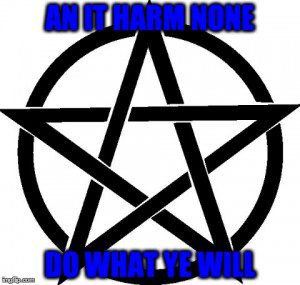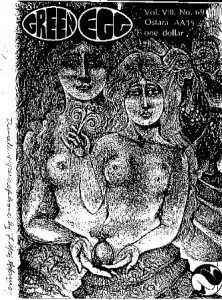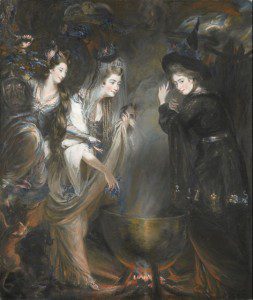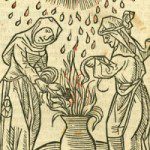 For many people the Wiccan Rede consists of eight words: “An it harm none, do what ye will.” Those words were first publicly uttered by Doreen Valiente back in October of 1964 at a dinner hosted by the Witchcraft Research Association. The phrase certainly goes back at least a little bit further than 1964, other Witches were using the Rede before that fateful October, but that dinner forty-nine years ago marks their first public utterance. (The word “Rede” itself means counsel or advice, which is exactly what the Wiccan Rede provides.)
For many people the Wiccan Rede consists of eight words: “An it harm none, do what ye will.” Those words were first publicly uttered by Doreen Valiente back in October of 1964 at a dinner hosted by the Witchcraft Research Association. The phrase certainly goes back at least a little bit further than 1964, other Witches were using the Rede before that fateful October, but that dinner forty-nine years ago marks their first public utterance. (The word “Rede” itself means counsel or advice, which is exactly what the Wiccan Rede provides.)
A statement very similar to the Rede appears in Gerald Gardner’s The Meaning of Witchcraft (published in 1959). In Meaning Gardner wrote: “Do what you like as long as you harm no one,” an idea he attributed to the legendary Good King Pausol. (1) If you’ve never heard of the “Good King Pausol” you aren’t alone. Pausole (Gardner forget the “e” in his book) wasn’t a legendary King at all, but the literary creation of the French writer Pierre Louÿs. Pausole first shows up in print back in 1901, with the English edition following 24 years later. If you look at the titles of Louÿs’s books and poems (The Flute of Pan, Aphrodite: Ancient Manners) it’s not surprising that Gardner was familiar with his work. In The Adventures of King Pausole the “legendary King” advises people that they should: “Do no wrong or harm to thy neighbor, and observing this, do as thou please.” (2)
Even older than Gardner’s “Do what you like” are several lines from Aleister Crowley’s Book of the Law originally written down in 1904. There are several bits in the BotL that are similar to the Rede. The most famous of these appear in verses 39, 40, and 57:
“The word of the Law is THELEMA . . . . Do what thou wilt shall be the whole of the Law . . . . . Love is the law, love under will. Nor let the fools mistake love; for there are love and love. There is the dove and there is the serpent. Choose ye well!”
“Do what thou wilt . . .” and “Love is the law” have gone on to become two of the most famous phrases in all of greater Occultdom, and Gardner certainly would have been familiar with them, as would any other serious student of magic(k) and the occult.
The philosophy expressed in Crowley’s Book of the Law has precedents, and Crowley himself freely admitted to this. The novel Gargantua by Fracois Rabelias originally published in 1554 contains these lines:
“Do as thou wilt because men that are free, of gentle birth, well bred, and at home in civilized company posses a natural instinct that inclines them to virtue and saves them from vice. This instinct they name their honor.
Crowley also mentions the influence of St. Augustine’s Homilies on the First Epistle of St. John on his operating system, specifically the phrase: “love and do what thou wilt.” (3) Kudos to Crowley for being upfront about his inspirations.
 To many though the Wiccan Rede is more than just a few words, it’s actually a big long poem consisting of 26 verses, only one of which contains the words “an it harm none do what ye will.” The “long version” of the Rede was first published in Earth Religion News back in the Spring of 1974. ERN was edited by Herman Slater, but the long Rede was most likely submitted by Eddie Buczynski, a former student of New England Witch Lady Gwen Thompson.
To many though the Wiccan Rede is more than just a few words, it’s actually a big long poem consisting of 26 verses, only one of which contains the words “an it harm none do what ye will.” The “long version” of the Rede was first published in Earth Religion News back in the Spring of 1974. ERN was edited by Herman Slater, but the long Rede was most likely submitted by Eddie Buczynski, a former student of New England Witch Lady Gwen Thompson.
A year after the publication of the long form Rede in Earth Religion News it was reprinted again in The Green Egg’s Ostara 1975 issue. In The Egg Lady Gwen Thompson revealed herself as the source of the extended Rede and claimed that it had originated with Adriana Porter (Thompson’s grandmother, though that was not mentioned in The Green Egg article, which you can read for yourself here). Thompson’s reasons for coming out as the author were numerous. Her Green Egg article takes other Witches to task, stating that they “ignore the age-old counseling of the Wise Ones as given in the Rede.” (Reading her article I’m inclined to agree.) Thompson also really wanted to clean up the long-form version of the Rede first printed in ERN. There, verses six and seven are noticeably different from Thompson’s version in tGE.
Below is Thompson’s Rede of the Wiccae (taken from the New England Covens of Traditionalist Witches page) along with the changed verses first published in ERN in parenthesis.
The Rede of the Wiccae as transmitted by Lady Gwen Thompson
Bide the Wiccan laws ye must
In perfect love an perfect trust.Live an let live-
Fairly take an fairly give.Cast the Circle thrice about
To keep all evil spirits out.To bind the spell every time
Let the spell be spake in rhyme.Soft of eye an light of touch
Speak little, listen much.Deosil go by the waxing moon
Sing an dance the Wiccan Rune.(Deosil go by waxing moon,
Changing out the Wiccan rune.)Widdershins go when Moon doth wane,
An the werewolves howl by the dread wolfsbane.(Widdershins go by waning moon,
chanting out the baneful rune.)
When the Lady’s Moon is new
Kiss the hand to her times two.When the Moon rides at her peak,
Then your heart’s desire seek.Heed the North wind’s mighty gale
Lock the door an drop the sail.When the wind comes from the South,
Love will kiss thee on the mouth.When the wind blows from the East
Expect the new an set the feast.When the West wind blows o’er thee
Departed spirits restless be.Nine woods in the cauldron go
Burn them quick an burn them slow.Elder be ye Lady’s tree
Burn it not or cursed ye’ll be.When the wheel begins to turn
Let the Beltane fires burn.When the Wheel has turned a Yule
Light the Log an let Pan rule.Heed ye flowers, bush an tree
By the Lady blessed be.Where the rippling waters go
Cast a stone an truth ye’ll know.When ye have need
Hearken not to other’s greed.With the fool no season spend
Or be counted as his friend.Merry meet an merry part
Bright the cheeks an warm the heart.Mind the Threefold Law ye should
Three times bad an three times good.When misfortune is enow
Wear the blue star on thy brow.True in love ever be
Unless thy lover’s false to thee.Eight words the Wiccan Rede fulfill
An it harm none, do what ye will.
The idea that Adriana Porter was the author or inheritor of Thompson’s Rede is initially difficult to take seriously. The word “Wiccan” was not in popular use before Gerald Gardner, and even if it was being used among English Witches it’s hard to imagine that information would have been transmitted across the Atlantic Ocean to a Witch in Boston. In addition the “Wiccan Rune” was a poem written by Gardner and Valiente somewhere between 1954 and 1955, that alone discounts at least verse six. The idea of the “threefold law” also postdates Porter, who died in 1946. (4)
Curiously though, there are parts of Thompson’s Rede which might be genuinely old. In The Rede of the Wiccae authors Robert Mathiesen and Theitic dissect every line of the long Rede and come up with some startling conclusions. Several of the rhymed couplets appear in other places, most notably in several collections of 19th Century Folklore. Even more amazingly there are several instances where the archaic language used in parts of the Rede actually follows old English grammar rules. (5) What this suggests, along with the information in the previous paragraph, is that Thompson’s version of the Rede had two different authors, perhaps both Porter and Thompson herself.
 Thompson’s “Grandmother Story” was never all that far fetched. According to Thompson, her Grandmother left her several papers tied together with a red ribbon. It was those papers that became the founding documents of Thompson’s Witch Tradition. It’s certainly possible that among those papers were several rhymed couplets, couplets that made up the majority of Thompson’s Rede. Magic survives, and a bustling city like Boston (where Porter spent much of her life) would have provided ample opportunities to learn and/or engage in it in the first half of the Twentieth Century.
Thompson’s “Grandmother Story” was never all that far fetched. According to Thompson, her Grandmother left her several papers tied together with a red ribbon. It was those papers that became the founding documents of Thompson’s Witch Tradition. It’s certainly possible that among those papers were several rhymed couplets, couplets that made up the majority of Thompson’s Rede. Magic survives, and a bustling city like Boston (where Porter spent much of her life) would have provided ample opportunities to learn and/or engage in it in the first half of the Twentieth Century.
If you were going to completely forge something I think the long-form Rede would look all together different. The only two sabbats listed in it are Yule and Beltane, which I find most odd. Why not write about Samhain or All Hollows? If the verses are Porter’s the lack of Halloween makes perfect sense, it wasn’t widely celebrated in the United States until after the second World War. There are also verses which reflect life at sea: “Nine woods in the cauldron go, Burn them quick an burn them slow.” That doesn’t make much sense to a land lover, but it’s what a sailor would have done, and Porter always lived in port cities. (6)
This is all speculation, because Thompson of course burned the writings of her Grandmother after copying them down in her own hand. (Why does every fabulous Witch story include “after she copied the original papers she destroyed them?”) (7) It’s certainly possible that Thompson simply borrowed her Rede from a variety of sources, but much of it seems to all come from one hand (with the “Wiccan verses” coming from another). I know many Witches who actively despise the long form version of the Rede, but I think it’s a fascinating bit of history and full of practical advice. I love lore and guidance that mixes our newer ways of doing things with the magical traditions that preceded both us and the pioneers of early Modern Witchcraft.
An it harm none, do what ye will!
(I was inspired to write this after reading The Rede of the Wiccae earlier this week, it then spiraled out of control to become a much longer 1800 word monster. Never let it be said that Jason is lazy in his writing or doesn’t care enough to tell the whole story!)
1. The Meaning of Witchcraft by Gerald Gardner first published in 1959. The version I have in my hand is the Red Wheel/Weiser edition published in 2004. The quote appears on page 108 of that edition.
2. Wicca: Magickal Beginnings by Sorita d’Este and David Rankine published by Avalonia Books in 2008. This is on page 61.
3. All of those quotes from Crowley and his influencers can be found on pages 62 and 63 of Wicca: Magickal Beginnings.
4. Go out and pick yourself up a copy of The Rede of the Wiccae: Adriana Porter, Gwen Thompson, and the Birth of a Tradition of Witchcraft by Robert Mathiesen and Theitic published in 2005 by Olympian Press. Yes, you’ll probably have to order it online, unless of course your local Pagan Store is supremely awesome. pages 76-77.
5. Pages 66 and 67 of The Rede of the Wiccae. You probably should read the whole thing.
6. See Mathiesen and Theitic page 72.
7. Page six of Mathiesen and Theitic

















